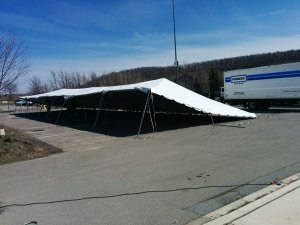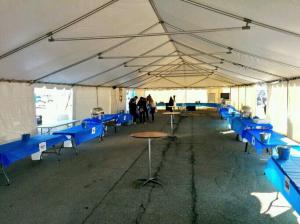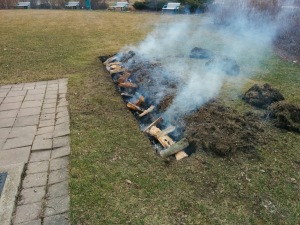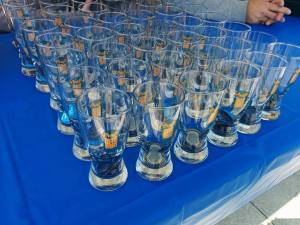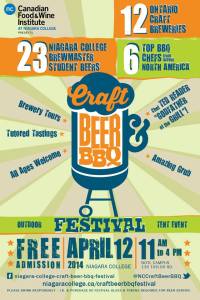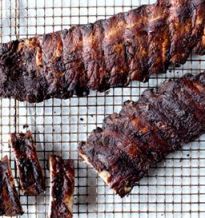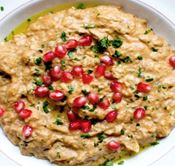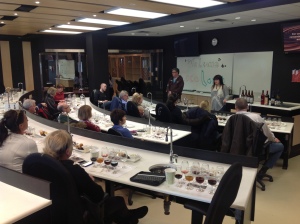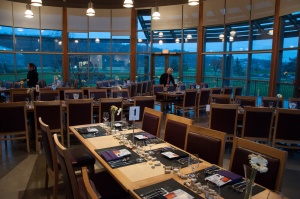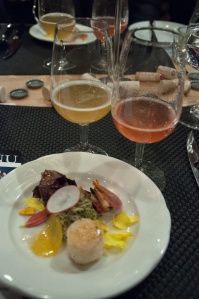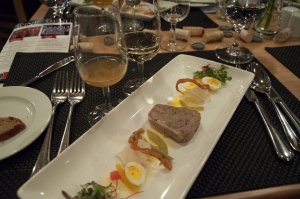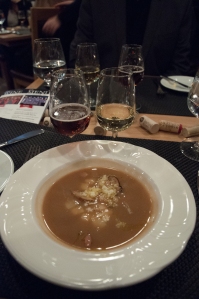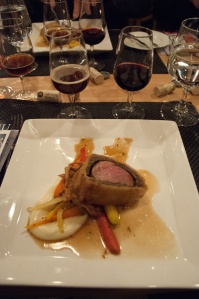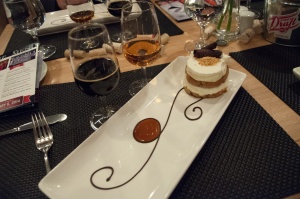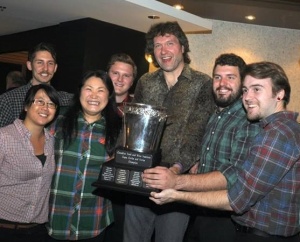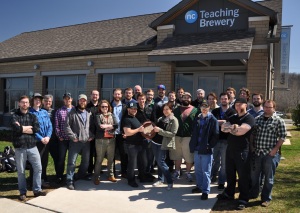Zeeeeeng!
Wow! The past two weeks have zipped by.
The week before last, while Brewmaster students were finishing off final assignments and studying for final exams, I was helping with final prep for the first-ever Niagara College beer festival. There were a bajillion little details to attend to: The DJ needs power — rent a generator. No wait, the college’s TV students are planning to park their mobile truck on site in order to broadcast the entire event. Order a larger generator. Or should we rent two generators? Cooking demos. Breweries. Smokers. Student volunteers. T-shirts for the student volunteers. Celebrity BBQ chefs. Menus. Getting Louisiana alligator carcasses across the border. Barbecue pit dug in the college lawn to slow-cook goat overnight. (May have forgotten to mention the barbecue pit to college authorities, under the “easier to ask for forgiveness than ask for permission” principle.) Festival glasses. Tokens. Age-of-majority wristbands. Student beer. Security. Fencing. Seventy-page AGCO Special Occasion Permit.
I was only helping with a few of these details. The real work was shouldered by Gary Torraville, the college’s Manager of Business, Student and Community Support; Sarah Scott, Manager of the on-campus Benchmark Restaurant; and the graduating class of Brewmaster students, who were handling a lot of the organizational details as part of their Sales & Promotions class.
We had our fingers crossed for reasonable April weather — we figured if it was above 5°C and not snowing, we could expect about 300 people. If it was cold and snowing, we’d be lucky to see 50 visitors. To be on the safe side, we ordered 600 glasses. There was no date on them, so we could always use leftovers next year, right?
On top of all of this, we also organized the first-ever Niagara College beer competition, open to any and all breweers, both amateur and professional, with results to be announced at the beer festival. Ah, but this meant the beer had to be judged before the festival. On top of festival prep, final exams and final assignments, graduating students had to judge the 100+ entries as part of their Sensory Evaluation course. (All beer was blind-judged according the the 2008 BJCP Style Guide.) Add 1st-place medals to the to-do list. Score sheets. Stewarding judging panels. Entering judging scores into a spreadsheet.
On top of that, Taps, a magazine devoted to the craft beer scene, had offered a very generous $3500 scholarship to the graduating Brewmaster student producing the best beer as part of their studies. So add student beers to the beer competition, and arrange the judging panels so a student isn’t judging a category that contains their own beer. Judging would determine the highest-scoring three beers, and we would then send those three beers to the Canadian Brewing Awards (the CBAs). The CBA judges would then pick a winner, and announce their decision at the upcoming CBA gala on May 31 in Fredericton, New Brunswick.
(Not meaning to digress, but Fredericton?? Seriously?? Fredericton is to craft beer what doughnuts are to a healthy lifestyle.)
And on top of everything else, we also planned a “Chef’s Signature” gala dinner the same evening, featuring our celebrity BBQ chefs, as well as the aforementioned alligator and goat (and many other dishes.)
Summary: We had our hands full the week before last.
The day of the festival finally arrived, and the weather was extraordinary for mid-April — a cloudless blue sky, and temperatures that topped 20°C. Between 11 a.m. and 3:30 p.m., 1400 people came through the gates. All 600 glasses were sold. We ran out of age-of-majority wristbands. Some of the celebrity chefs ran out of food. Some of the brewers ran out of beer.
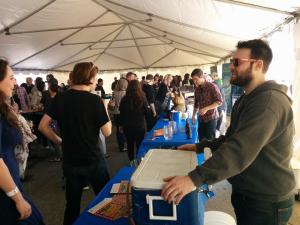
Brewmaster graduates Sebastian MacIntosh (foreground) and Asa Proveau (background) pour beer for Flying Monkeys and Sawdust City respectively.
Of course we had some problems. There were lineups to get into the festival grounds, lineups to buy a festival glass and lineups to get into the beer tent. On the plus side, everyone had a great time, and the worst hazard of the day seemed to be sunburn.

Ken Woods, president of Black Oak, explains the natural superiority of “10 Bitter Years” Double IPA to thirsty customers.
We announced the first-, second- and third-place winners of our open beer competition in fifteen categories. The biggest winner overall was Mill St. Brewing, which walked away with two first-place medals, as well as four second-place and two third-place awards. (Mill St. employs several Brewmaster graduates in its brewhouse.)
However, I thought the big winner was the Brewmaster program: Of the 46 possible prizes, 16 were won by beers created by Brewmaster students. (Remember, they were up against professional brewers.) Jamie Shillow, a graduating student, won two first place medals — one for her special project beer brewed in the Teaching Brewery, and one for a homebrewed raspberry ale. Just as impressive was first-year Brewmaster student Graeme Nichol, who won two first-place medals for homebrewed beers. Amazing.
The Brewmaster program scored even higher if you take into account the winning beers that were brewed by Brewmaster graduates. In addition to the already-mentioned Brewmaster grads working at Mill St., the awards list included Mark Murphy (Brewmaster ’12) of Left Field Brewing — 1st-place medal in the IPA category for Resin Bag IPA; Scott Pautler (Brewmaster ’13) of Old Flame Brewing — 1st-place medal in the Dark Lager category; Aaron Spinney (Brewmaster ’12) of Sawdust City Brewing — 1st-place medal in the Light Hyrbid category for Sawdust City Kölsch; Elliot Herman (Brewmaster ’12) of Silversmith Brewing — 1st-place medal in the German Wheat & Rye Beer category for Bavarian Wheat; and Mark Horsley (Brewmaster ’12) of Nickel Brook Brewing — three 2nd-place awards for Cuvée, Bolshevik Bastard, and Naughty Neighbour.
Adding them all up, beer brewed by Brewmaster students and Brewmaster graduates walked away with 35 of 46 awards. Remember, the Brewmaster program is only four years old. Can you imagine what is going to happen to the quality and creativity of craft beer when every brewery employs at least one Brewmaster grad?
The three beers chosen as finalists for the Taps Magazine scholarship were equally as impressive: Fumé, a smoked saison created by Christine Nagy; Hop Shotta, an American IPA created by Graham McMullen; and Bloody Pale Ale, a tomato pale ale created by Adam Shell. I’m sure each of those graduates is holding his or her breath until the scholarship winner is announced on May 31.
However, no time to waste, with the competition winners and scholarship finalists announced, it was 4 p.m. and time to close the festival and clean up. Then turn around and get ready for the gala dinner.
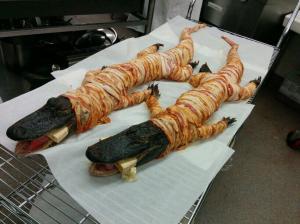
Bacon-wrapped alligators from a Louisiana bayou head out to the grill for an afternoon of slow-cooking.
This was no dinner for vegetarians. We had barbecued beef, pork, chicken, goat, lamb, salmon and alligator. In keeping with the barbecue theme, service was “family style” — we just passed platters of food up and down the tables. Lots of food. Lots and LOTS of food.
I was finished before the third course was served. Could not move. Could not eat another bite. Then another course went by. And another course. Then they brought out delicious apple, cherry and pecan pies. Okay, maybe I could have just another small bite.
The aftermath of the big weekend was, not surprisingly, a bit anti-climactic. The big tents came down. The students wrote their final exams, shook hands and had a big end-of-semester party before hitting the road. I paid bills, sent out press releases about the weekend and marked exams.
And that was the semester. Done. Finished. A third Brewmaster class graduated. Where did the time fly?
However, no time to waste. In order to accommodate more Brewmaster students, we have moved to a “year-round” stance, starting 18 new students down the path to brewmastery every four months. So even as the latest batch of students leaves, the newest batch begins their journey starting in only two weeks…
